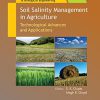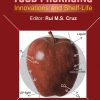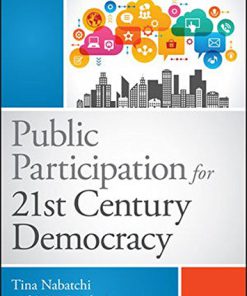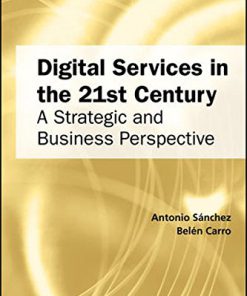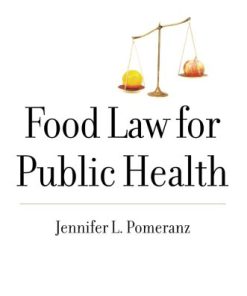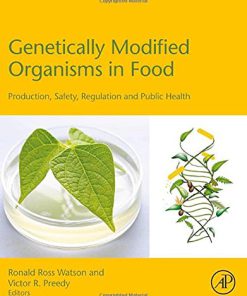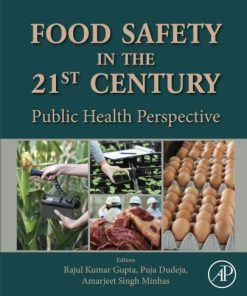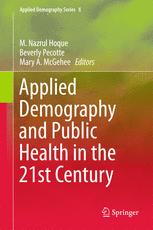Food Safety in the 21st Century Public Health Perspective 1st Edition by Puja Dudeja,Rajul Gupta,Amarjeet Singh Minhas 9780128017739 0128017732
$50.00 Original price was: $50.00.$25.00Current price is: $25.00.
Food Safety in the 21st Century Public Health Perspective 1st Edition by Puja Dudeja,Rajul Gupta,Amarjeet Singh Minhas – Ebook PDF Instant Download/Delivery:9780128017739,0128017732
Full download Food Safety in the 21st Century Public Health Perspective 1st Edition after payment
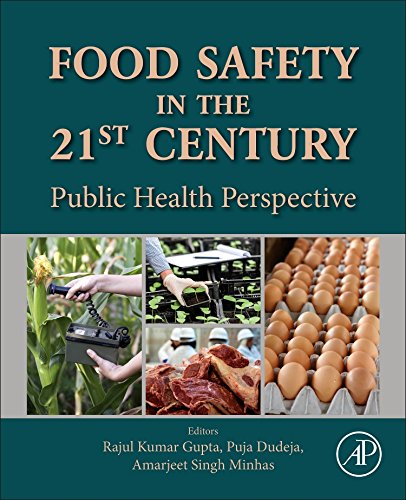
Product details:
ISBN 10:0128017732
ISBN 13:9780128017739
Author:Puja Dudeja,Rajul Gupta,Amarjeet Singh Minhas
Food Safety in the 21st Century: Public Health Perspective is an important reference for anyone currently working in the food industry or those entering the industry. It provides realistic, practical, and very usable information about key aspects of food safety, while also systematically approaching the matter of foodborne illness by addressing the intricacies of both prevention and control.
This book discusses ways to assess risk and to employ epidemiological methods to improve food safety. In addition, it also describes the regulatory context that shapes food safety activities at the local, national, and international levels and looks forward to the future of food safety.
Food Safety in the 21st Century Public Health Perspective 1st Table of contents:
Section 1: Epidemiological aspects of foodborne diseases
Chapter 1: Foodborne diseases—disease burden
Abstract
1.1. Introduction
1.2. Factors Affecting Burden of FBD
1.3. Foodborne Zoonotic Diseases
1.4. Noninfection-Based FBD
1.5. Seasonal Variation of FBD
1.6. Challenges in Assessment of Burden of FBD
1.7. Assessment of Disease Burden
1.8. WHO Estimates of the Global Burden of FBD
1.9. WHO Region-Wise Disease Distribution
1.10. FBD in India
1.11. Public Health Impact of the Burden
Chapter 2: Foodborne infectious diseases
Abstract
2.1. Classification
2.2. Infectious Diseases Spread by Food
2.3. Infections Versus Intoxication
2.4. Transmission
2.5. Food Poisoning
2.6. Salmonellosis
2.7. Staphylococcal Food Poisoning
2.8. C. perfringens Food Poisoning
2.9. Botulism Food Poisoning
2.10. B. cereus Food Poisoning
2.11. E. coli Food Poisoning
2.12. Norovirus Gastroenteritis
2.13. Sanitation of Some Specific Foods
2.14. Foodborne Diseases of Fungal Origin
2.15. Aflatoxicosis
2.16. Foodborne Diseases Caused by Toxic Agents
2.17. Lathyrus Toxin
2.18. Epidemic Dropsy
2.19. Conclusions
Chapter 3: Outbreak investigation of foodborne illnesses
Abstract
3.1. Introduction
3.2. Trigger Events
Chapter 4: Surveillance of foodborne illnesses
Abstract
4.1. Definition
4.2. Set Objectives
4.3. Data Collection and Consolidation
4.4. Data Analysis and Interpretation
4.5. Evaluation (Silverman et al., 2009; German et al., 2001; Thacker and Stroup, 1994; WHO, 2013)
4.6. Dissemination (Orenstein and Bernier, 1990; WHO, 1998; 2012)
4.7. Integrated Disease Surveillance Project (IDSP, 2009)
4.8. Surveillance Systems in the United States of America (Centers for Disease Control and Prevention, 2015a,b)
4.9. Conclusions
Chapter 5: Role of risk analysis and risk communication in food safety management
Abstract
5.1. Introduction
5.2. Risk Analysis
5.3. Risk Analysis Process
5.4. Risk Assessment
5.5. Risk Assessment Policy
5.6. Risk Management
5.7. General Principles of Food Safety Risk Management
5.8. Risk Management Framework
5.9. Risk Communication
5.10. Conclusions
Section 2: Food safety issues in contemporary society
Chapter 6: An ayurvedic perspective on food safety
Abstract
Chapter 7: Food safety in modern society—changing trends of food production and consumption
Abstract
7.1. Introduction
7.2. Changing Trends in Food Production
7.3. Changing Trends in Food Consumption
7.4. Hazards Due to Safety Aspects of Food
Section 3: Food contamination and adulteration
Chapter 8: Food toxicology—past, present, and the future (the Indian perspective)
Abstract
8.1. Introduction
8.2. The History of Food Toxicology
8.3. The Modern History
8.4. Radiation Contamination of Food and Water
8.5. Toxic Waste Imports in India
8.6. Toxicology and Crime
8.7. Poison Control/Information Centers in India
8.8. Food Safety of VVIPs
8.9. Food Security in India
8.10. International/National Activities for Health Protection
8.11. Indian Acts/Laws for Food Safety
8.12. Remedial Measures
Chapter 9: Toxicological profile of Indian foods—ensuring food safety in India
Abstract
9.1. Introduction
9.2. Classification of Toxins/Toxicants
9.3. Adulteration of Foods
Chapter 10: Detection of food adulterants/contaminants
Abstract
10.1. Introduction
10.2. Definition of Adulterant/Contaminant and Adulteration
10.3. Economic Adulteration
10.4. Common Adulterants/Contaminants in Foods
10.5. Impact of Food Adulteration on Human Health
10.6. Artificially Ripened Fruits and Mercury Pollution in Fish
10.7. List of Adulterants/Contaminants in Foods and Their Health Effects
10.8. Detection of Adulterants/Contaminants
10.9. Simple Screening Tests for Detection of Adulteration at Home
10.10. Conclusions
Chapter 11: Recent advances in detection of food adulteration
Abstract
11.1. Color as Food Additive: Detection Methodologies
11.2. Preservatives as Food Additives
11.3. Harmful Aspects of Food Preservatives
11.4. Other Adulterants: a Challenge for Detection
11.5. Conclusions
Chapter 12: Role of public health food safety laboratories in detection of adulterants/contaminants
Abstract
12.1. Introduction
12.2. Conclusions
Section 4: Food safety from farm-to-fork
Chapter 13: Food-safety issues related to plant foods at farms
Abstract
13.1. Introduction
13.2. Fragmented Approach to Food Safety in Past
13.3. Integrated Approach: Farm-to-Fork
13.4. Food Safety at the Farm Level
13.5. Methods to Reduce Hazards at the Farm Level
Chapter 14: Food safety from farm-to-fork—food safety issues related to animal foods at farm
Abstract
14.1. Animals at Farm
14.2. Safe Animal Feed
14.3. Animal Welfare
14.4. Animal Health
14.5. Animal Living Conditions
Chapter 15: Food safety from farm-to-fork—food-safety issues related to processing
Abstract
15.1. Hygiene of Staff
15.2. Training of Staff
15.3. Design of Plant
15.4. Maintenance and Sanitation
15.5. Control of Operations
15.6. Product Information and Consumer Awareness
15.7. Record Maintenance for GMPs
15.8. GMP-System Verification
Chapter 16: Food safety issues in production of foods of animal origin and from farm to plate
Abstract
16.1. Introduction
16.2. Food Safety Issues During Primary Production
16.3. Preslaughter Safety of Meat Animals During Transportation
16.4. The Indian Legislation on Meat Business
16.5. Slaughtering of Animals
16.6. The Slaughterhouse
16.7. Slaughtering
16.8. Poultry Meat
16.9. Veterinary Inspection
16.10. Antemortem Inspection
16.11. Postmortem Inspection
16.12. Meat Food Safety in Domestic Kitchens
16.13. Food Safety Issues During Storage
16.14. Food Safety Controls
16.15. Meat Processing and Marketing
16.16. Food Retailing
16.17. Role of Consumer
16.18. Conclusions
Chapter 17: Safe storage and cooking practices for foods of animal origin in home kitchen before consumption
Abstract
17.1. Introduction
17.2. Safe Production and Storage of Foods of Animal Origin
17.3. Storage of Foods of Animal Origin
17.4. Handling and Cooking of Foods of Animal Origin in Kitchen
17.5. Preparing Food Safely at Home
17.6. Cooking of Meat or Fish
17.7. Method of Thawing of Frozen Food in a Microwave Oven
Section 5: Food safety is a shared responsibility: role of various stakeholders in implementing food safety
Chapter 18: Role of government authorities in food safety
Abstract
18.1. History of Food Laws in India
18.2. Authorities Under PFA
18.3. New Era of Food Laws in India
18.4. Key Provisions of FSSA
18.5. Important Definitions as Per FSSA
18.6. Other Highlights of FSSA
18.7. Challenges
18.8. Other Government Agencies Working for Food Safety
18.9. Conclusions
Chapter 19: Local governing bodies
Abstract
19.1. Introduction
19.2. Local Governing Bodies in India
19.3. Responsibilities of the State/District Food Safety LGB
19.4. Responsibility of Municipal Council/Corporation
19.5. Food Safety Plan
19.6. Role of Food Safety Officer (FSO)
19.7. Responsibility of Other Departments/Ministries
19.8. Conclusions
Chapter 20: Role of food business operators in food safety
Abstract
20.1. Responsibilities of FBO
20.2. Challenges
20.3. The Way Forward
Chapter 21: Food handlers
Abstract
21.1. Responsibilities of Food Handler
21.2. Food-Safety Requirements for Food Handlers Under Food Safety and Standards Regulations (FSSR 2011)
21.3. Training of Food Handlers
21.4. Occupational Hazards of Food Handlers
21.5. Prevention of Occupational Hazards in Food Handlers
Chapter 22: Consumers
Abstract
22.1. Introduction
22.2. Consumers’ Perspective About Food Safety
22.3. Government’s Initiative in Creating Consumer Awareness
22.4. Manufacturer’s Initiatives to Protect Consumer Welfare
22.5. Conclusions
Chapter 23: Public health professionals and food safety
Abstract
23.1. Studying
23.2. Teaching and Training
23.3. Disease Surveillance
23.4. Information, Education, and Communication (IEC)
23.5. Specific Advice and Professional Consultations
23.6. PHP in Public Health Laboratory (PHL)
23.7. Early Diagnosis of Disease
23.8. Investigation of Foodborne Outbreak
23.9. Tackling a New Foodborne Disease
23.10. Documentation and Reporting
23.11. Advisories, Consultancy, and Advocacy
23.12. Policy Making and Administration
23.13. Research
23.14. Leadership
23.15. Conclusions
Chapter 24: Role of veterinary experts in food safety
Abstract
24.1. Introduction
24.2. Role of Vets in Food Safety Controls and Food Safety Plan
24.3. Scope of Veterinary Education in India
24.4. Role of Vets in Public Health Through Veterinary Public Health in Implementation of Principles of Risk Analysis in Food Safety
24.5. Role of Vets in Preventing Antimicrobial Resistance in Public Health
24.6. Conclusions
Chapter 25: Researchers and food safety
Abstract
25.1. Introduction
25.2. Who is a Researcher?
25.3. Need of Research in Food Safety
25.4. Research in Food Safety
25.5. Food-Safety Research During Food Production Processes
25.6. Postharvest
25.7. Active Packaging
25.8. Contribution of Specific Branches of Science to Food-Safety Research
25.9. Conclusions
Chapter 26: Role of hotel management and catering technology institutes in ensuring food safety
Abstract
26.1. Hotel and Catering Industry
26.2. Education and Training of Hotel and Catering Industry Personnel
26.3. Government Initiative in Creating Infrastructure for Education in this Sector
26.4. Importance of Food Safety Education and Training in Hotel and Catering Industry
Section 6: Food safety in large eating establishments
Chapter 27: Food safety in large organized eating establishments
Abstract
27.1. Introduction
27.2. Food Safety Requirements in an EE
27.3. Kitchen Equipment as Food Safety Hazard
Chapter 28: Design and construction of eating establishments for ensuring food safety
Abstract
28.1. Obtaining Approval and Permit to Operate a Food Service
28.2. Characteristics of Good Kitchen Design
28.3. Internal Structures and Fittings
28.4. Workspace Dimensions
28.5. Construction Requirements
28.6. Equipment Design and Installation
28.7. Sinks
28.8. Storage Space
28.9. Grease Traps
28.10. Pipe Work
28.11. Gratings
28.12. Waste Disposal Systems
28.13. Ventilation
28.14. Lighting
28.15. Insect Control
28.16. Basic Fire Precautions
28.17. First-Aid Kits
28.18. Conclusions
Section 7: Food safety in small eating establishments and in special situations
Chapter 29: Safe cooking practices and food safety in home kitchen and eating establishment
Abstract
29.1. Safe Cooking Practices and Food Safety in Home Kitchen and Eating Establishemnt (EE)
Chapter 30: Food safety in schools, canteens, hostel messes, mid-day meal scheme, ICDS
Abstract
30.1. General Principles of Food Safety for Community Eating Establishment (Gupta, 2009)
30.2. Principles of Food Safety Specific to Various Community Eating Establishments/Programs
Chapter 31: Food safety issues related to street vendors
Abstract
31.1. Definition of Street Food
31.2. Increasing Trend of Street Foods
31.3. Food Safety Hazards
31.4. Food Safety Practices Pertaining to Street Foods and Their Health Implications
31.5. Food Safety Regulatory Requirements
31.6. Policy Issues for Provision of Safe Food
31.7. Conclusions
Chapter 32: Food safety during travel
Abstract
32.1. Introduction
32.2. Food Borne Diseases
32.3. Determinants of Food Safety During Travel
32.4. Common Tips for Ensuring Food Safety in All Modes of Travel
32.5. Mode of Travel
32.6. Conclusion
Chapter 33: Food safety during fairs and festivals
Abstract
33.1. Introduction
33.2. Food Safety Hazards During Fairs and Festivals
33.3. Causes of Food Borne Illness During Fairs and Festivals
33.4. Measures to Ensure Food Safety During Fairs and Festivals
33.5. Conclusions
Chapter 34: Food safety during disasters
Abstract
34.1. Food Safety Advice
34.2. Preparation for Food Safety Before a Disaster (WHO, 2015b)
34.3. Principles of Feeding Programs During Disasters (UNHCR, 1999)
34.4. Food Safety Measures in the Aftermath of Natural Disasters (WHO, 2015a)
34.5. Conclusions
Section 8: Domestic regulatory scenario of food safety and interface of food safety laws, standards, regulations, and policies at the international level
Chapter 35: Relevant food safety regulations and policies
Abstract
35.1. Introduction
35.2. Evolution of Food Laws
35.3. Indian Food Laws
35.4. Food Safety Policies
35.5. Procedure for Implementing Food Legislations/Instructions
35.6. Registration of Petty FBOs
35.7. Licensing of FBOs
35.8. International Scenario on Food Safety
Chapter 36: Food safety policies in agriculture and food security with traceability
Abstract
36.1. Introduction
36.2. Has National Agricultural Policy Taken Care of “Food Safety”?
36.3. Food Safety and Food Security as Part of National Agricultural Policy
36.4. Traceability
Chapter 37: Food safety in international food trade—imports and exports
Abstract
37.1. Introduction
37.2. Principles and Guidelines of Inspection and Certification Systems for Imports and Exports
37.3. Principles of Food Import and Export Inspection and Certification (CAC/GL 20, 1995)
37.4. Guidelines
37.5. Guidelines on Food Import-Control System
37.6. Food Export-Control System
37.7. Equivalence
37.8. Inspections
37.9. Certification Systems
37.10. Conclusions
Chapter 38: Regulation of advertisement for food products in India—advertisement for food products
Abstract
38.1. Introduction
38.2. Advertisement Policies for Food Safety
38.3. Food Safety Guidelines
38.4. Food Safety and Standard Regulations (FSSR), 2011
38.5. Jago Grahak Jago
38.6. Who Can File a Complaint?
38.7. How to File a Complaint?
38.8. Where to File a Complaint?
38.9. The Horlicks Controversy
38.10. The Way Forward
38.11. Conclusions
Section 9: Food safety concerns in context of newer developments in agriculture/food science/food processing
Chapter 39: Nutritional labeling
Abstract
39.1. Introduction
39.2. Nutrition Labeling as Per Food Safety and Standards Act (FSSA) 2006
39.3. Nutrition Facts Panel
39.4. Ingredient List
39.5. Nutrition Claims Versus Health Claims
39.6. Other Claims
39.7. Percentage (%) Daily Value
39.8. Nutritional Information and Dietary Changes
39.9. Nutrition Labels in Packaged Food: “Eat” in Between the Lines
39.10. Conclusions
Chapter 40: Nutraceuticals
Abstract
40.1. Introduction
40.2. Nutraceutical
40.3. Classification of Nutraceuticals
40.4. Mode of Action of Nutraceuticals
40.5. Benefits of Nutraceuticals
40.6. Regulation Governing Nutraceuticals
40.7. Conclusions
Chapter 41: Regulatory requirements for labeling, health, and nutritional claim
Abstract
41.1. Introduction
41.2. General Requirements for Mandatory Labeling
41.3. Claims
41.4. Prohibitions
41.5. Conclusions
Chapter 42: Genetically modified (GM) foods: the food security dilemma
Abstract
42.1. Applications of GM Crops
42.2. Pharming
42.3. GM Crops in India
Chapter 43: Organic farming: is it a solution to safe food?
Abstract
43.1. Introduction
43.2. Definition of Organic Agriculture
43.3. Adverse Effects of Modern Agricultural Practices: Indian Context
43.4. Origin of Organic Farming
43.5. The Concept of Food Quality and Food Safety
43.6. Food Safety in Organic Agriculture: The Evidence
43.7. Public Concern About Safe Food and its Quality
43.8. Technique of Organic Farming
43.9. Basic IFOAM Principles of Organic Farming: Complement to Food Safety
43.10. Organic Agriculture: International Perspective
43.11. Organic Farming at National Level
43.12. Promotion of Organic Foods: What is Needed?
43.13. Organic Food: Certification
43.14. The Way Forward
Chapter 44: Safety and quality of frozen foods
Abstract
44.1. Introduction
44.2. Food Spoilage/Deterioration Leading to Unsafe and/or Poor Quality Food
44.3. Methods of Food Preservation for Enhancing Shelf Life of Food
44.4. Freezing as a Method of Food Preservation
44.5. Methods of Thawing
44.6. Safety and Quality of Frozen Foods
44.7. Moisture Loss/Freezing Injury
44.8. Microbial Growth in the Freezer
44.9. Effect on Nutrient Value of Frozen Foods
44.10. Effect of Thawing on Safety and Quality of Food
44.11. Conclusions
Chapter 45: Ready to eat meals
Abstract
45.1. Introduction
45.2. History
45.3. The Indian Setting
45.4. Limitations
45.5. Classification
45.6. Safety Aspects of REM Foods
45.7. Detection of the Foodborne Pathogenic Bacteria
45.8. Food Safety Concern for Some Specific REM
45.9. Conclusions
Chapter 46: Food packaging
Abstract
46.1. Introduction
46.2. History
46.3. Why Food Packaging?
46.4. Principles of Packaging
46.5. Packaging and Food Safety
46.6. Packaging Material
46.7. Types of Packaging
46.8. Packaging Materials
46.9. Labeling
46.10. Toxic Effects
46.11. Emerging Trends
46.12. Conclusions
Chapter 47: Information technology (IT) in food safety
Abstract
47.1. Where are We?
47.2. Where IT Comes in?
47.3. Prerequsites of IT System
47.4. Present Usage of IT in Food Safety: Developing Countries
47.5. IT in Food Safety: Developed Countries
47.6. Cyber Security in Food Safety (Straka, 2014)
47.7. Limitations of IT
47.8. Future of IT in Food Safety
People also search for Food Safety in the 21st Century Public Health Perspective 1st:
food safety in the 21st century
food safety in the 21st century public health perspective
food safety in the 21st century pdf
food safety in the early 1900s
how has food safety changed in the 21st century
Tags:
Puja Dudeja,Rajul Gupta,Amarjeet Singh Minhas,Food,Perspective
You may also like…
Politics & Philosophy - Social Sciences
Relationships & Lifestyle - Diet & Nutrition
Community Mental Health: Challenges for the 21st Century Jessica Rosenberg
Medicine
Food law for public health 1st Edition by Jennifer L Pomeranz ISBN 9780190227258 0190227257
Politics & Philosophy
Biology and other natural sciences - Biotechnology
Politics & Philosophy
Applied Demography and Public Health in the 21st Century 1st Edition Nazrul 3319436880 9783319436883
Uncategorized


